Loughatalia
Houses within 5km of this house
Displaying 29 houses.
Houses within 5km of Loughatalia
Displaying 29 houses.
| House name | Description | |
|---|---|---|
| Ballyvodock | Thomas Wigmore occupied this house in the mid 19th century. He held it from the representatives of Viscount Midleton and it was valued at £9+. | |
| Roxborough | Wilson, writing in 1786, refers to "Rocksborough" as the seat of Mr. Ball. The residence of Bent Ball in 1814 and of - McSweeny in 1837, this house was unoccupied in the early 1850s when it was valued at £22. The immediate lessor was Sir A. Brooke. The house has disappeared by the time the 25-inch Ordnance Survey map was published in the 1890s and the Youghal branch of the Great Southern & Western railway constructed close by. | |
| Ahanesk | A house on the shore of Cork Harbour occupied by William Oliver Jackson at the time of Griffith's Valuation and held by him in fee. It was valued at £24. In 1906 a mansion house in the townland of Ballyvodock East was valued at £98. The house passed by marriage to the Sadlier Jackson family and in the mid 20th century became the home of the Lomers. |
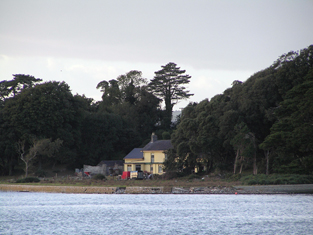
|
| Ballyvodock House | James Barry was living at Ballyvodig House, Middleton, in 1814. In the mid 19th century William Kelleher was the occupier. He held the property from William Oliver Jackson and the buildings were valued at £11. A house and large farm are still extant at the site. | |
| Ballintubbrid House | Ballintobrid, Middleton, was the home of William Weekes in 1814. By 1837 it was the home of the Heard family and occupied and held by Edward Heard in fee at the time of Griffith's Valuation. The house was valued at £13. The original house is not extant. | |
| Ballyannan | The Brodricks first occupied Ballyannan Castle, a fortified house in the townland of that name, which was in ruins by 1837. In 1786 Wilson refers to Ballyanan"belonging to Lord Viscount Midleton". On the first Ordnance Survey map there is a building named Ballyannan House (W867 715) right on the shore close to the castle and there is a house in the townland of Garryduff named Ballyannan. Ballyannan was occupied by Roger Adams in 1814 and by J. Adams in 1837. At the time of Griffith's Valuation the representatives of Viscount Midleton occupied a house and offices valued at £19 in the townland of Garryduff. The house in the townland of Ballyannan was valued at £9.10 shillings and was occupied by Daniel Twomey and held from the Viscount. | |
| Ashgrove | A branch of the Rogers family was located at Ashgrove in the early 18th century. Described by Bence Jones as a late Georgian house built for Councillor Franklin by Abraham Hargrave and now a ruin. In 1810 Townsend referred to the new house of Richard Frankland "built in the best modern style". It was occupied in 1814 by Mrs Franklan and in 1837 by R. Frankland. Richard Frankland held the property in fee at the time of Griffith's Valuation when the buildings were valued at £32. |

|
| Belgrove | A house possibly inherited by the Bagwells through marriage with the Harpers. The residence of J. Travers in 1814 and of the Reverend G. Gumbleton in 1837 and in the early 1850s. The Reverend Gumbleton held the property from John Bagwell and it was valued at £36. Bence Jones writes that William Gumbleton, son of the Reverend, lived in this house under 1911. The house was demolished in the mid 20th century and a new building erected. | |
| East Grove | Bence Jones writes that this early 19th century house was built by Dorcas Bousfield, daughter of William Bagwell and his wife Jane Harper. After her death it was inherited by the Bagwells and remained in their possession until the mid 20th century. In 1837 John Bagwell is recorded as the proprietor of East Grove and also in the early 1850s, when the property was valued at £40 and held from the representatives of Viscount Midleton. In 1942 the Irish Tourist Association Survey noted that it was the residence of Major Bagwell and the adjacent grounds contained the remains of buildings thought to be "the now-unknown castle of Ballinakilla". 20th century owners included Lorretta Brennan Glucksman, and the Kelly family, musicians. In recent years it has been offered for sale. |

|
| Maryland House | The residence of Joseph Haynes in 1837 and the early 1850s, held by him from William Player at the time of Griffith's Valuation and valued at £20. A cornmill was located closeby. Maryland is no longer extant. | |
| Rose Hill | At the time of Griffith's Valuation Alexander McNab held Rose Hill House valued at £15 with 120 acres from the Marquess of Thomond. The National Inventory of Architectural Heritage shows a house at this location dating from the 1890s. |
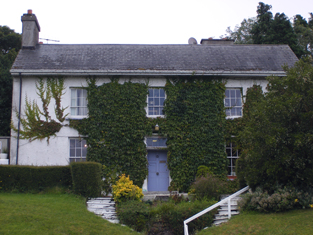
|
| Jamesbrook Hall | The home of the Adams family, occupied by Michael Go[o]ld Adams in 1814 and by Richard W. G. Adams in 1837 and in the early 1850s when the house was valued at £60 and held from the Marquess of Thomond. Occupied by William R. G. Adams in 1906. Recently renovated and restored. |

|
| Rostellan | Seat of the Marquess of Thomond, occupied by him in in 1786 (Lord Inchiquin. It was at £79 in the early 1850s. Bought by Dr T.A. Wise after the Marquess's death in 1855, a lithograph of the house is included in the sale rental. Subsequently purchased by Sir John Pope Hennessy and mentioned by Slater as the residence of Lady Pope Hennessy in 1894. Occupied by Charles J. Engledew and valued at £112 in 1906. The Irish Tourist Association survey noted in the early 1940s that the roof and fittings had recently been removed and the land taken over by the Land Commission. No trace of the house remains now. |

|
| Cloyne House | Originally the Bishop's Palace, by 1837 it was known as Cloyne House and occupied by H. Allen. Valued at £50, occupied by John Wilkinson and held from the Ecclesiastical Commissioners at the time of Griffith's Valuation. |
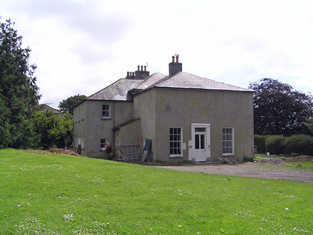
|
| Lindsey Cottage | Marked on the first Ordnance Survey map as Lindsey Cottage. At the time of Griffith's Valuation it was occupied by John Litton who held it from the Bishop of Cork, Cloyne and Ross. The buildings were valued at £20. | |
| Castle Mary | An 18th century house, remodelled as a castle in the 19th century, home of a branch of the Longfield family. In 1786 Wilson give a description of the house including that "the west front of this mansion presents a view of Cork Harbour". Valued at £85 in the mid 19th century and held by Mountifort Longfield in fee. Bence Jones writes that this house was burnt in the early 1920s and is now a ruin. A new house was constructed from the old stable courtyard and the family continued to live there for periods of time during the 20th century until Castle Mary was acquired by the Hurley family in 1978. |
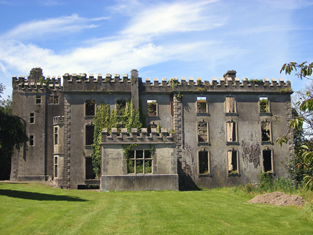
|
| Rathcoursey House (East) | At the time of Griffith's Valuation a house in Rathcoursey East valued at £18 was held by Richard Lyons from the Provost and Fellows of Trinity College, Dublin. This house is still a residence. |

|
| Rathcoursey House (West) | Home of the Smith family in the 18th and 19th centuries. John Tynte Smyth lived here in the 1770s. Occupied by John Smith in 1814 and John J. Smyth in the early 1850s. The house was valued at £35 and held from the Marquess of Thomond with 214 acres. It is now run as a guest house. |

|
| Ardavilling | The National Inventory of Architectural Heritage dates this house circa 1860. It was the home of John Litton who left it to his nephew Edward F. Litton. At the beginning of the 20th century occupied by Guildford William Jack Stacpoole of the Ballyalla, county Clare, family. |
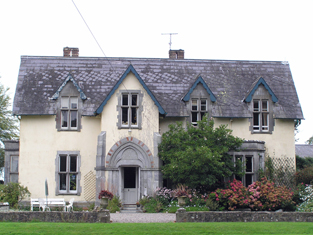
|
| Ballynacorra | An 18th century house, occupied by John Garde in 1814 and by Thomas Garde at the time of Griffith's Valuation, who held the building valued at £40 from the Earl of Shannon. Still in use as a residence. | |
| Broomfield | A home of the Garde family in the second half of the 18th century. The residence of D. Humphreys in 1837 and of William Humphreys in the early 1850s. At this time the house was valued at £30 and held from the representatives of Viscount Midleton. This house is still in use as a residence. |

|
| Butlerstown | Daniel Keane lived at Butlerstown in the early 1850s. The buildings were valued at £15 and held from the representatives of Viscount Midleton. This house is now a ruin. | |
| Rose Hill | Occupied by William Rumly in 1814 and Lewis records T.H. Rumbley residing at Ballinacorra Lodge in 1837. Mountiford Longfield was the occupier in the early 1850s. Held by him in fee and valued at £15. This house is no longer occupied. |
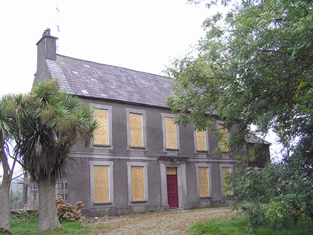
|
| Lakeview | Located on the southern outskirts of Midleton town, Swithin Fleming is recorded as the occupier of this house on the Midleton estate and 12 acres from at least 1837 until the 1870s. In the mid 19th century it was valued at £14. | |
| Dunsfort | Occupied by Richard Adams in 1814 and by Laurence Smithwick at the time of Griffith's Valuation when valued at £20 and held from the representatives of Viscount Midleton. Only the farm buildings appear to be shown on the 25-inch map of the 1890s. | |
| Killeagh | A house on the Midleton estate occupied by W. Welland in 1837 and Henry Welland at the time of Griffith's Valuation. He held the house valued at £40 with 427 acres. William Welland of Brooklodge, Middleton, owned 185 acres in the 1870s. This house now known as Westpark House is still a family residence. |

|
| Woodview | A house marked on the first Ordnance Survey map and occupied in 1837 by the Reverend J.P. Lawless. Valued at £18 at the time of Griffith's Valuation, occupied by the Reverend John L. Pyne and held from Mountifort Longfield. The location appears to be occupied by farm buildings now. | |
| Carrigshane | Thomas Smithwick held a house valued at £15 with 44 acres from the representatives of Viscount Midleton at the time of Griffith's Valuation. This may be the property mentioned by Wilson as "Carrig" in 1786, a seat of the Uniacke family. Buildings are still extant at this site. | |
| Cahermone | Wilson, writing in 1786, refers to Cahermone as the seat of Charles Broderick. The house was the residence of Thomas Poole in 1814 and in 1837. Lewis states that Poole was agent to the Midleton estates. Laurence Smithwick occupied the house at the time of Griffith's Valuation when it was valued at £8. Though buildings there were vallued at £19 in 1906 the original house is not shown on the 25-inch Ordance Survey map of the 1890s. Farm buildings occupy the site now. |

